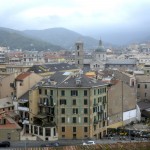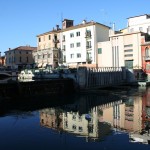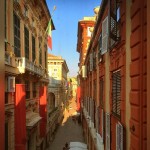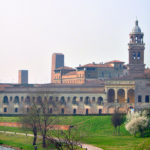A city with three souls: Modern, Art Nouveau and Medieval
Milan: tour of the Monumentale Cemetery
Just like an open-air museum that could tell the history of the city!
The Monumentale Cemetery is probably Milan’s most important location. Above the central entrance we see the statue of Gloria, that welcomes the illustrious names of our country’s past.
The Cemetery itself, it is virtually an open-air park museum: the tombs and the burial chapels are constructed in different styles and built in different ways, that could tell the history of the city of Milan!
⇒ Watch the full web serie Milan & Leonardo da Vinci
Cover pic courtesy of Flickr User Marco (@scatto_felino)
Visit Turismo Milano official website
Video full text: Tour of the Monumentale Cemetery
I’m late for my visit to what is probably Milan’s most important location.
The Monumentale Cemetery in Milan!
There is a guide who is explaining things.
Above the central entrance we see the statue of Gloria,
that welcomes the illustrious names of our country’s past.
This part of the monument is called the famedio (memorial chapel),
that was to have been a church but was then used to accommodate the famous names of Milan.
The famedio, from the Latin fame aedes (temple of fame)
is the main entrance to the Monumentale Cemetery,
that was built between 1864 and 1868, to a design by Carlo Maciachini.
We climb this majestic flight of steps and enter the actual famedio.
Beneath the sky blue vault of the famedio lie the most important tombs:
Alessandro Manzoni, Giuseppe Verdi and Carlo Cattaneo.
Now the problem is this: it was built at the end of the 19th century,
and naturally, they put those people in here that were important at the time.
But how does one decide “who is famous”?
Who is it who decides which of these individuals is to be honoured with a burial in the famedio?There is a specific committee that has been in place since 1927. Since then the committee, consisting of the presidency of the city’s Municipal Council, every year selects 14 names that can be admitted into the famedio’s pantheon.
Names that have made Milan famous the world over:
Luca Ronconi, Elio Fiorucci, Enzo Iannacci and Franca Rame.
We’re now making our way into the cemetery itself.
Ahead of us is the central avenue with parallel avenues that intersect one another at 90 degrees.
It is virtually an open-air park museum.
The tombs and the burial chapels are constructed in different styles and built in different ways
that could tell the history of the city of Milan.
Giancarlo Maciachini managed to combine more than one style in a harmonious amalgamation:
from Pisan Romanesque, to Lombard Gothic to the Byzantine of Ravenna.
There are also so many examples of Liberty, so many styles.
There’s architectural eclecticism here to suit all tastes.
We have the Duomo, in miniature.
There’s the inevitable Egyptian style with the papyrus flowers!
What I find really striking, set against this backdrop of death,
is a rustic depiction of Mother Earth, with two oxen pulling.
A recurring image is that of the female figure,
like a sort of reminder of the bosom, a return to the womb.
Some of these images are also very erotic,
they reflect the period, and have this idea of love and Thanatos.
This too is part of their beauty and the beauty of the cemetery.
This is dedicated to Isabella Airoldi, a young woman who perhaps died in child birth, at the age of twenty-four. she was the wife of a noble baron Casati.
The bare bosom caused quite a stir at the time.
In the middle of the necropolis we find a majestic monument.
There are around twenty panels containing more than 110 fully-rounded statues.
Throughout the 20th century the Milan’s well-to-do families almost challenged one another
in order to leave their mark on the Monumentale.
The size of the Falck family’s burial chapel increased on a par with that of the Bocconi family,
as though they were competing against each other.
The extension of the chapel kept pace with the family’s financial fortunes.
If it was extended, it meant they had made some money.
Over there is the monument to the Campari family, and it depicts the last supper.
And what comes to mind is that it is not a supper, but more of an aperitif.
It is an imposing monument and one of the best known in the Monumentale.
It takes up Leonardo’s idea of the last supper.
We see the chalice that is out of proportion to everything else.
Some say it is because it alludes to the family’s business,
others say it is because it is the Holy Grail and we don’t know its actual size.
Take a careful look. Can anyone tell me where Judas is and how did you recognise him?
Judas is the ugliest and meanest looking, the one with the cantankerous face.
Well done!
Another point of interest. If we move to the rear, we can see the bag with the coins.
It actually has the face of Judas.
Down there we can see the new skyscrapers, an incredible view
that says to us “you may beaver away in life” but when all is said and done we all end up here,
and leave empty-handed!
As we enter this world, so we leave it.
We can build all the monuments we like,
but let’s remember that all that we leave behind is what we have done.
Visit Milan: helpful hints
Italian name: Milano
Arrival
Milan has got three airports:
- Malpensa Airport is the largest international & intecontinental Airport in Northern Italy. 30 miles Northwest from the city centre. Connections:
→ Train Malpensa Express: trains leaves every 30 minutes in each direction, connecting the Airport to Milan Grand Central Station or Cadorna Railway Station. Terminals 1 and 2. It takes 45 min, price: 14 €
→ Shuttle Bus: Malpensa Shuttle and Malpensa Bus Express connect the airport to Milan Grand Central Railway Station and Milan’s Underground Network. Terminals 1 and 2. It takes 60/70 min, price: 8 € - City Airport Linate is an international airport connecting Milan with main European cities, located just 4 miles from the city centre. Connections by shuttle: Atm Bus n. 73 from Milano Duomo M1 – M3 (Piazza Diaz, direction: San Babila), first ride at 5.35 am, last one at 00.35. Frequency: every 10 min, price 1,5 €
- Milan Bergamo Airport Orio al Serio is mainly low cost flights Airport, located 30 miles Northwest from Milan. Connections only by Shuttle: There are 4 different bus companies, pricing changes from 5 up to 8 €
Transports
ATM is Milan public transport service both for bus, tram and subway. Single ticket costs 1.50€ for 90-min ride. Consider daily/weekly subscriptions. You can buy tickets also texting to 48444. Milan Subway is the longest in Italy, covering 95 km: Donwload and check the map.
Moving in town can be nice also by bike: Milan has got a powerfull bike sharing service providing both regular and e-bikes. Here is the experience of our Ambassador Kim Harding with BikeMi service and a useful video of our Ambassador Roxana explaining how does it work. Car Sharing is also good with many different companies to choose.
Try also the local urban railway train, called Passante Ferroviario, check the experience of our Ambassador Roxana Iacoban travelling by local train in town.
What to do in Milan
Milan is the Italian financial center and one of the European capitals of Fashion. Known for its nightlife as well.
Some tips on Italia Slow Tour: watch our web serie about Leonardo da Vinci’s places, climb on top of the Duomo, visit Prada Foundation, Museums and Art Galleries, taste some fine gelato and try the local Aperitivo and – not joking – enjoy a sailing trip (!!) or some time deep in the nature close to some actual farms and fields.
Where to sleep
Accomodations are quite expensive in Milan, fares rise up and hotels get full according to the rich event calendar of the city (see: Fashion Week, Salone del mobile, Big concerts, Theatre and Sport events, etc.). If you are not specifically interested in any of those, try to travel during other periods to save some money.
Italia Slow Tour recommends:
- Hotel Cervo in Garibaldi District if you want to stay close to city centre and enjoy the nightlife
- Hotel Concorde located on the Green Way Milan-Lecco to Lake Como, if you want to move around adn travel by bike
Shopping in Milan
The famous Fashion District involves the following streets/areas: Via Montenapoleone, via Manzoni, via della Spiga and Corso Venezia. The so called “Quadrilateral of Fashion”. Here you can find all kind of brands and shops. Easy to reach by Subway (stop at Montenapoleone station).
Don’t miss the Street Markets! Almost every day you can find one: best are the ones in Viale Papiniano (on Tuesday) and Via Fauchè (on Saturday). More on the official website of weekly street markets. If you are into sustainable local products, Milan has got 8 actual farms in town and a green Earth Market.
If you are interested in Outlet Shopping, in the outskirt of Milan you can find 4 different Fashion Outlets, in a radius of 62 miles. Here you can find everyday a lot of famous high quality Italian brands on sale, with prices cut off up to 50%. All the outlets are connected to the center of Milan by Shuttle Bus:
- Serravalle Designer Outlet – Shuttle departure from Milan Central Station or Cairoli square
- Fidenza Village Outlet Shopping – Shuttle departure from Piazza della Repubblica 5, at the corner with Turati st.
- Vicolungo The Style Outlets – Shuttle departure from Cairoli square
- Rodengo-Saiano Franciacorta Outlet Village – Shuttle departure from Cairoli square














